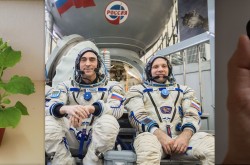Puncturing the Cosmic Microwave Background Radiation

The cosmic microwave background (CMB) is light that has been travelling towards us for almost the entire age of the Universe. The light was set on its path at the moment atoms formed, just 400,000 years after the big bang, and about 13.8 billion years ago. As the Universe matured and expanded, galaxies and galaxy clusters formed, hot beds of star formation, gas, dust, black holes, and other matter. As the light from the big bang encountered the galaxy clusters, the hot gas would scatter the light away. Finally, 13.8 billion years later, the CMB light gets to Earth, but with voids in it coverage of the sky. There are dark holes, where no CMB light made it through. These holes, or voids, betray the galaxy clusters encountered along the way.
In this image from Astronomy Picture of the Day, two different kinds of light have been overlain on top of each other. An image from the Atacama Large Millimeter Array (ALMA; sees radio light) displays the CMB in blue. The rest of the image was taken with the Hubble Space Telescope, which sees in optical/UV. The yellow smudges are galaxies, and the black void is where the hot gas has scattered the CMB light.


























